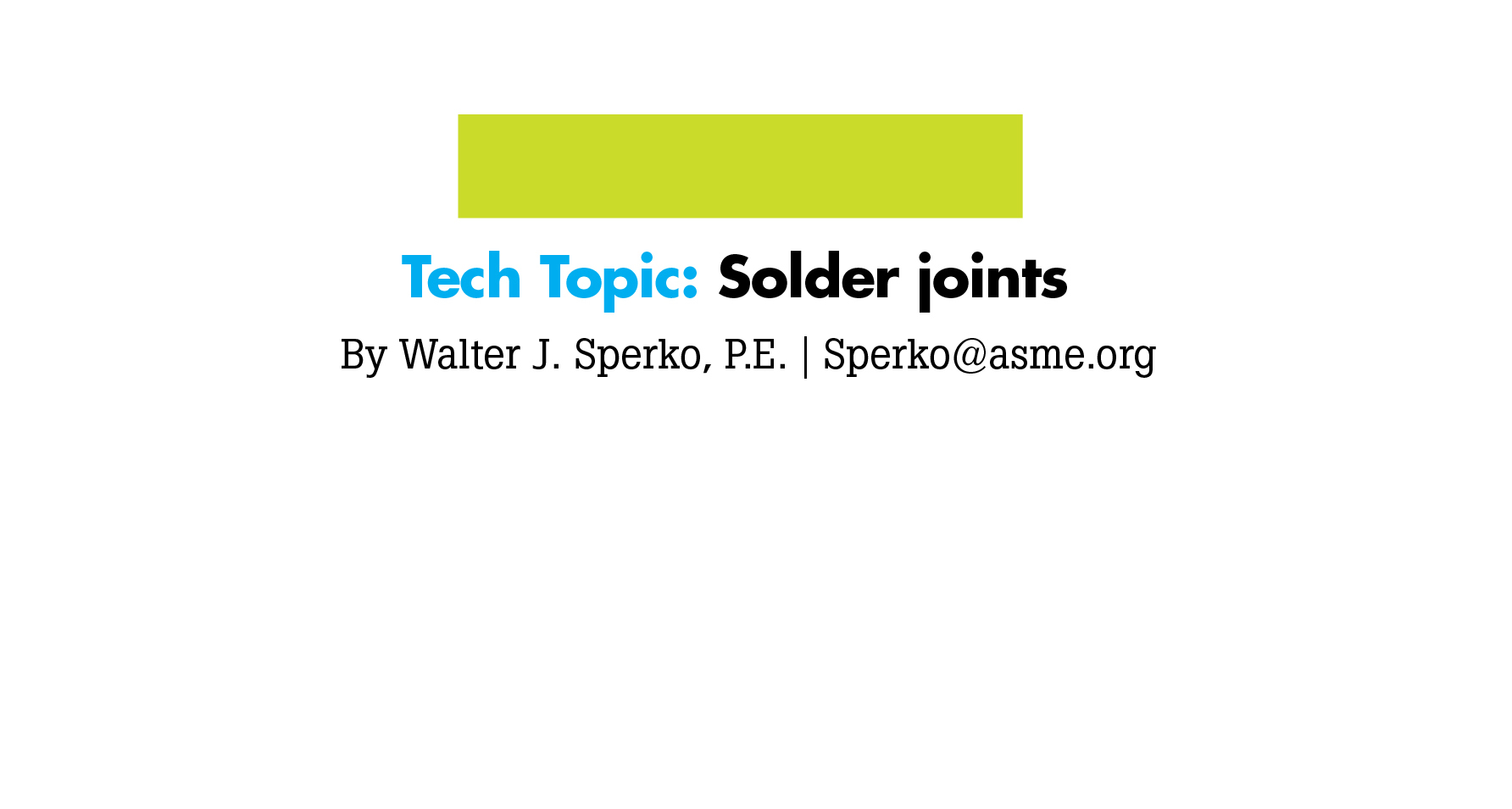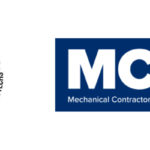Looks Can Be Deceiving
A soldered or brazed joint may have issues not seen by the naked eye
by Walter J. Sperko
PDF version of this article available here.
The integrity of soldered – and brazed – tube joints depends on whether or not the solder or braze metal flows into the capillary space created by the overlap between the tube and the socket to a sufficient depth that the resulting joint is as strong as the tube itself.
 An illustration of “overlap” is shown in Figure 1.
An illustration of “overlap” is shown in Figure 1.
Unless you have X-ray vision, once a soldered or brazed joint is made, it’s hard to tell how well the craftsperson filled the joint. If a joint is not properly heated, it might look good and have enough fill of the bonding area shown in Figure 1 to pass a hydrostatic test, but it could fail in service if the filler metal does not adequately fill the joint. This is especially true for soldered joints since solder, which is mostly tin, will creep – defined as a slow, permanent deformation of a solid material under the influence of mechanical stresses – at room temperature if the stress is high enough.

Figure 2 shows a cross-section of a brazed joint that only is partially filled; the unfilled crevice is a notch that intensifies the stress at the interface between the members and if there is any vibration, that notch will propagate and eventually result in a leak.
Nondestructive examination of brazed and soldered joints
So how do you verify that a soldered or brazed joint is properly filled? One can X-ray such a joint, but copper tubes and fittings are so thin you have to use an X-ray tube at low voltage to reveal incomplete fill, and X-ray tubes are terribly inconvenient to use in the field.
 Ultrasonic examination is another option. It would seem that a simple ultrasonic thickness gauge could find unfilled areas in soldered or brazed joints, but simple thickness gauges don’t work. You need a 3/16-inch diameter, 10 MHz dual-crystal transducer and electronics with an oscilloscope-type display to ensure accuracy as shown in Figure 3.
Ultrasonic examination is another option. It would seem that a simple ultrasonic thickness gauge could find unfilled areas in soldered or brazed joints, but simple thickness gauges don’t work. You need a 3/16-inch diameter, 10 MHz dual-crystal transducer and electronics with an oscilloscope-type display to ensure accuracy as shown in Figure 3.
 To ensure a proper setup, a brazed or soldered assembly that only is brazed or soldered halfway around the fitting as shown in Figure 4 should be used. Separate samples are required for soldered and brazed joints since the acoustic properties of solder and braze metal are different.
To ensure a proper setup, a brazed or soldered assembly that only is brazed or soldered halfway around the fitting as shown in Figure 4 should be used. Separate samples are required for soldered and brazed joints since the acoustic properties of solder and braze metal are different.
 The technician should be able to show the thickness of the fitting, the tube and, at the brazed or soldered joint, the sum of the fitting thickness plus the tube thickness. The technician can then scan joints and map out filled and unfilled zones as shown in Figure 5. I have successfully used this arrangement on sockets down to 1/2-inch tube size joints.
The technician should be able to show the thickness of the fitting, the tube and, at the brazed or soldered joint, the sum of the fitting thickness plus the tube thickness. The technician can then scan joints and map out filled and unfilled zones as shown in Figure 5. I have successfully used this arrangement on sockets down to 1/2-inch tube size joints.
Acceptance criteria for brazed and soldered joints
In evaluating the unfilled areas, the criteria for acceptance will be different for soldered joints and brazed joints.
Since solder is much softer than braze metal, the tube should be inserted to the full depth of the solder joint cup and about 80 percent of the joint should be filled. Further, the unfilled area should not extend most of the length of the cup as shown in Figure 5, since the only thing that prevents such a joint from leaking is the little fillet at the visible surface of the joint.
The best way to fix a badly soldered joint is to reheat and disassemble the joint, clean off the excess solder, then reassemble the joint and resolder it. Such a joint should easily solder since the tube and socket faying surfaces will already be mostly tinned.
Determining the extent of fill needed in a brazed joint is another matter. A brazed joint will be just as strong as the base metal if the overlap length that is soundly brazed is twice the thickness of the thinner member — that’s how much stronger braze metal is than solder.
For those who might be skeptical that this is sufficient overlap, I would point to branch-connection joints made using a tee-forming machine such as that made by T-Drill and others where the extruded neck length of an outlet hole is about 1/4-inch; this is sufficient to develop full strength in the joint when the joint is made by brazing.
There is an ASME specification (B16.50) for copper-braze joint fittings and it specifies cup depths that are significantly shorter than those required by B16.22 for soldered joints. See Table 1 (below).
While you can buy B16.50 fittings, the fittings you receive will be B16.22 fittings since B16.50 only specifies a minimum cup depth but no maximum. Fittings manufacturers have good reason to not sell you short-cup brazejoint fittings: lawyers. Were a contractor to buy braze-joint fittings with short cups and were his craftsperson to solder them rather than braze them, the joints would fail in service and not only would the contractor be sued, but so would the fittings manufacturer.
Heating a 2-inch solder joint fitting that has a 1.34-inch deep cup up to 1,400° F and filling the gap completely with braze metal is a real challenge for the brazer. As sizes get larger, the challenge increases. As stated above, however, if the joint is sound for a depth of more than twice the thickness of the thinner member being joined, that joint will be just as strong as the copper itself.
However, the crevice formed by the unfilled portion of the joint is a stress-concentrating notch, and if there is vibration, flexing or other cyclic loading of the joint, that notch will propagate along the joint, causing a leak – and leaks are never good.
Table 1
Solder and Braze Joint Fitting and Copper Tube Dimensions
| Tube Size | B16.22
Socket Depth |
B16.50
Socket Depth |
Socket Thickness | Copper Tube
Type K |
Thickness
Type L |
| 3/8 | 0.38 | 0.20 | 0.023 | 0.049 | 0.035 |
| 1/2 | 0.50 | 0.22 | 0.029 | 0.049 | 0.040 |
| 3/4 | 0.62 | 0.25 | 0.033 | 0.065 | 0.045 |
| 1 | 0.75 | 0.28 | 0.040 | 0.065 | 0.050 |
| 1-1/4 | 0.97 | 0.31 | 0.044 | 0.065 | 0.055 |
| 1-1/2 | 1.09 | 0.34 | 0.051 | 0.078 | 0.060 |
| 2 | 1.34 | 0.40 | 0.059 | 0.083 | 0.070 |
| 2-1/2 | 1.47 | 0.47 | 0.067 | 0.095 | 0.080 |
| 3 | 1.66 | 0.53 | 0.075 | 0.109 | 0.090 |
| 3-1/2 | 1.91 | 0.59 | 0.086 | 0.120 | 0.100 |
| 4 | 2.16 | 0.64 | 0.096 | 0.134 | 0.110 |
| 5 | 2.66 | 0.73 | 0.111 | 0.160 | 0.125 |
| 6 | 3.09 | 0.83 | 0.124 | 0.193 | 0.140 |
| 8 | 4.09 | 1.28 | 0.173 | 0.200 | 0.271 |

When examining a brazed joint, the braze metal should be completely around the joint for a length equal to the depth of socket shown in Table 1 for B16.50 braze-joint fittings. The remainder of the fitting should be filled with braze metal for full length for not less than 2/3 of the circumference to ensure adequate rigidity in the joint, thereby avoiding propagation of the notch resulting from incomplete fill.
Reducing the depth that the tube is inserted into the fitting makes the joint much easier to braze, especially for larger joints:
- It is much easier to completely fill the joint;
- It takes half the time to make a large joint;
- It takes less braze metal to make such a joint;
- There is no open crevice that can trap dirt and bacteria as shown in Figure 6; and
- The gap between the tube ends always is wide open as shown in Figure 7, allowing effective flushing when needed.
While one could instruct brazers to only insert the tube partway into the fitting, it would be a hit-or-miss approach, especially in the field. One also could shorten the fitting by trimming off the excess socket material – a very labor-intensive option.
 One also could modify the fitting so the tube does not slide all the way in by putting a limit stop inside the fitting. That is easily done using a product such as the Brazing Dimpler® or something similar shown in Figure 8. This tool forms a dimple on the outside of the fitting, which protrudes on the inside of the fitting 0.5 inch, or so back from the fitting end.
One also could modify the fitting so the tube does not slide all the way in by putting a limit stop inside the fitting. That is easily done using a product such as the Brazing Dimpler® or something similar shown in Figure 8. This tool forms a dimple on the outside of the fitting, which protrudes on the inside of the fitting 0.5 inch, or so back from the fitting end.
One protrusion is sufficient to stop the tube from sliding past it, but three equidistant dimples are recommended to keep the fitting aligned with the axis of the tube. Using a manual method is good for fittings up to 3-inch size and the automated version shown in Figure 9 is good for all sizes.
 At this point, you probably want to know if partial insertion is acceptable for brazed joints, particularly if you are doing medical gas piping under NFPA-99; that standard permits modifying the fitting as follows. 5.1.10.4.6.1: “Tube ends shall be inserted into the socket, either fully or to a mechanically limited depth that is not less than the minimum cup depth (overlap) specified by ASME B16.50, Wrought Copper and Copper Alloy Braze-Joint Pressure Fittings.”
At this point, you probably want to know if partial insertion is acceptable for brazed joints, particularly if you are doing medical gas piping under NFPA-99; that standard permits modifying the fitting as follows. 5.1.10.4.6.1: “Tube ends shall be inserted into the socket, either fully or to a mechanically limited depth that is not less than the minimum cup depth (overlap) specified by ASME B16.50, Wrought Copper and Copper Alloy Braze-Joint Pressure Fittings.”
Plumbing codes do not address use of modified braze-joint fittings, nor do they require full insertion when brazing. Since methods of modifying solder-joint fittings to convert them to braze-joint fittings are acceptable under NFPA-99 that should be good enough for plumbing, too.
It is possible to examine brazed and soldered copper tube joints using ultrasonic examination and to easily and accurately map out the extent of incomplete fill. The extent of incomplete fill that is acceptable is an engineering decision that should be made with understanding what is necessary to make a brazed or soldered joint that is suitable for service. Engineers should consider specifying 100 percent ultrasonic examination on 1.5-inch, and larger pressure fittings and random examination of smaller fittings using the acceptance criteria given above.
Finally, it is possible to modify solder-joint fittings to make them suitable for brazing, which results in faster and easier brazing with higher-quality joints than when using unmodified fittings.
Walter J. Sperko, P.E., is president of Sperko Engineering, a welding, brazing and metallurgical engineering consulting firm specializing in ASME Code applications. He worked for a major EPC firm, ITT Grinnell, and or Richmond Engineering before founding Sperko Engineering in 1981. He is a member of several ASME and AWS technical committees. He can be reached at Sperko@asme.org or at 336-674-0600.



